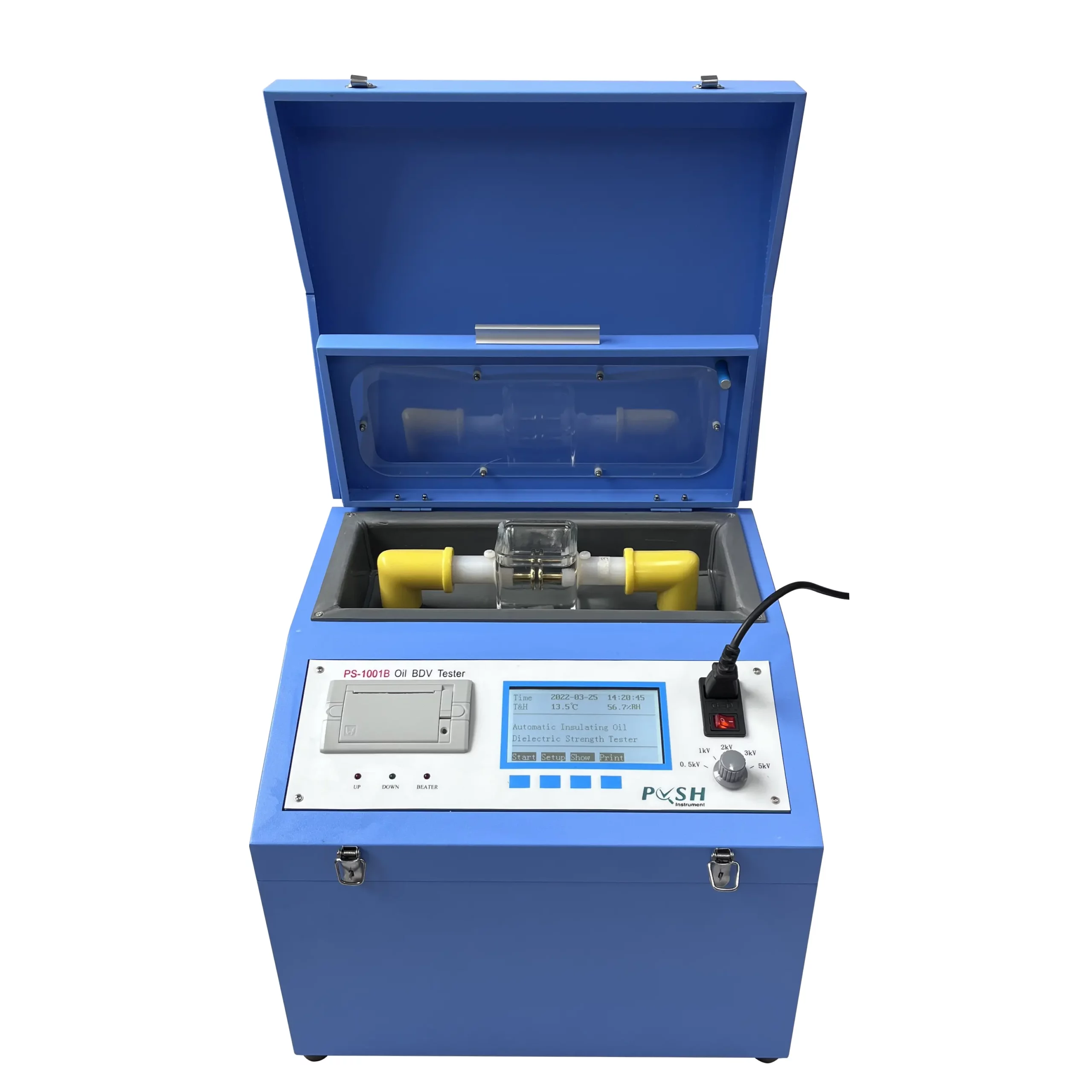A Breakdown Voltage (BDV) Testing Kit is a crucial instrument used to determine the breakdown voltage of insulating oils, which is a critical parameter in assessing the quality and effectiveness of these oils in electrical equipment.
Here’s how a BDV Testing Kit typically works:
1. Sample Preparation: A representative sample of the insulating oil to be tested is collected and placed in a test cell, which is designed to withstand high voltages without breakdown.
2. Electrodes: The test cell is equipped with a pair of standardized, closely spaced electrodes. These electrodes are designed to create an electric field within the oil sample.
3. Oil Immersion: The insulating oil sample completely immerses the electrodes within the test cell.
4. Voltage Application: The BDV Testing Kit generates a high-voltage AC (alternating current) signal. The test cell and electrodes are connected to this voltage source.
5. Gradual Voltage Increase: The voltage is applied to the electrodes, and it is gradually increased at a controlled rate. The rate of voltage increase is typically specified in testing standards and can vary depending on the specific test method used.
6. Monitoring for Breakdown: As the voltage continues to increase, the electric field within the insulating oil becomes more intense. At a certain point, when the voltage reaches the breakdown voltage of the oil, a breakdown or discharge occurs. This breakdown event may manifest as a visible flash, a sudden increase in current, or an audible noise.
7. Voltage Recording: The BDV Testing Kit continuously records the voltage at which the breakdown occurred. This recorded voltage is the breakdown voltage of the insulating oil.
8. Repeatability: BDV testing is often conducted multiple times to ensure the repeatability of results and verify the accuracy of the recorded breakdown voltage.
9. Interpretation: The recorded breakdown voltage is compared to specified standards and industry guidelines. If the recorded breakdown voltage meets or exceeds the minimum requirements, the insulating oil is considered suitable for its intended application. If the breakdown voltage falls below the required value, it may indicate a problem with the oil’s insulating properties.
10. Reporting: The results of the BDV test, including the breakdown voltage and any relevant details, are documented and reported for quality control, maintenance, and compliance purposes.
BDV testing is critical in assessing the condition of insulating oils used in electrical equipment, such as transformers and switchgear. It helps identify potential issues, such as contamination, degradation, or the presence of impurities, which can adversely affect the oil’s ability to insulate and protect electrical components. The specific procedures and standards for BDV testing may vary depending on the industry and application.
What safety considerations and precautions should be followed when operating a BDV Testing Kit to ensure the safety of personnel and the testing environment?
Operating a BDV (Breakdown Voltage) Testing Kit involves working with high voltages and electrical equipment, which requires strict adherence to safety considerations and precautions to ensure the safety of personnel and the testing environment.
Here are important safety measures to follow when operating a BDV Testing Kit:
- Qualified Personnel: Only trained and qualified personnel who have a thorough understanding of high-voltage testing equipment should operate the BDV Testing Kit. bdv testing kit Training should include safety protocols, test procedures, and emergency response.
- Personal Protective Equipment (PPE): All operators should wear appropriate PPE, including safety glasses, gloves, flame-resistant clothing, and appropriate footwear. Insulated gloves and sleeves are essential when handling high-voltage components.
- Controlled Access: Limit access to the testing area to authorized personnel only. Unauthorized individuals should not be allowed in the vicinity of the testing equipment.
- Safety Barriers: Set up physical barriers and warning signs to prevent unauthorized access to the testing area and to keep personnel at a safe distance from the equipment.
- Emergency Shutdown: Ensure that an emergency shutdown procedure is in place, and all personnel are trained to execute it in case of an emergency or unsafe condition.
- Electrical Isolation: Before performing any maintenance or adjustments, ensure that the testing equipment is de-energized, properly grounded, and disconnected from the power source to prevent accidental discharges.
- Grounding and Bonding: Maintain proper grounding and bonding of the testing equipment to avoid electrical hazards, such as electric shock. Grounding should be in accordance with safety regulations and standards.
- Ventilation: Ensure proper ventilation to disperse any potential fumes or gases that may be generated during testing. This is particularly important if the insulating oil being tested might emit odors or gases.
- Emergency Response Plan: Develop and communicate an emergency response plan that outlines procedures for dealing with accidents, spills, fires, electrical shock, or other emergencies. Ensure all personnel are familiar with the plan.
- First Aid: Train personnel in basic first aid procedures, especially for electrical shock. Maintain first aid supplies in the testing area.
- Inspection and Maintenance: Regularly inspect the BDV Testing Kit and associated equipment for signs of wear, damage, or malfunction. Perform maintenance and calibrations as recommended by the manufacturer.
- Equipment Testing: Before testing insulating oils, ensure that the BDV Testing Kit is in proper working order and has been de-energized, grounded, and disconnected from the power source.
- Safety Data Sheets: Maintain access to safety data sheets (SDS) for any insulating oils being tested. SDS provides important information about potential hazards.
Compliance with safety regulations, industry standards, and the equipment manufacturer’s guidelines is essential when operating a BDV Testing Kit. A rigorous safety culture should be fostered, emphasizing the importance of safety in all testing procedures.
